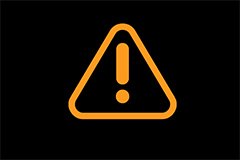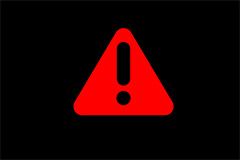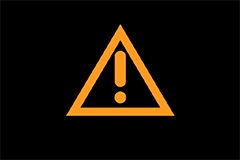One of my clients once said when I asked about this triangle light in his car:
“I’ve had the triangle with exclamation point symbol on for two years. It doesn’t mean anything. It’s just a glitch.”
No. It’s not a glitch!
If you share the same thought as him, kindly remove it from your mind and keep reading this post to know exactly what it means.
By the end of this guide, you’ll have a clearer understanding of the triangle with exclamation point warning light and the appropriate steps to take when it comes on.
Ready to get started? Let’s dive in!
What Does the Triangle with Exclamation Point Mean?
The triangle with an exclamation point is commonly referred to as the ‘Master warning light’ or ‘Central warning light’.
This warning light appears on the dashboard to indicate that there is a malfunction in your car system.
The specific meaning of this light can depend on the make and model of the vehicle. Look at the table provided below to determine the precise significance of your vehicle.
| Brand | Symbol | Meaning |
|---|---|---|
| Audi |  | If there is a serious system malfunction, the display may turn off. The indicator light may also turn on. Stop the vehicle safely. See an authorized Audi dealer or authorized Audi Service Facility for assistance. |
| Audi |  | When the ignition is in the ON position, the master warning light illuminates if any of the following is displayed on the vehicle information display. • No key warning • Low windshield-washer fluid warning • Door open warning (when stopped) • Trunk open warning • Loose fuel cap • Low tire pressure warning • AWD warning If the master warning light illuminates and the message(s) are not visible on the vehicle information display, use the buttons located on the steering wheel to navigate the vehicle information display until the “Warnings” screen is displayed. |
| BMW |  | This warning light alerts you to any malfunctions in the system. It is monitoring if a malfunction should occur with your vehicle. A warning lamp may appear along with a corresponding check control symbol in the center of the instrument cluster. |
| BMW |  | If the indicator lamp flashes: Dynamic Stability Control (DSC) or Dynamic Traction Control (DTC) is regulating the drive and braking forces. If the indicator lamps are on: DSC or DTC is deactivated. |
| Honda |  | Blinks when Vehicle Stability Assist (VSA) is active. Comes on if there is a problem with the VSA system, brake assist system, hill start assist system, starting assist brake function, or agile handling assist. Stays on constantly - Have your vehicle checked by a dealer. Comes on if the VSA system is deactivated temporarily after the battery has been disconnected, then re-connected. Action to be taken: Drive a short distance at more than 12 mph (20 km/h). The indicator should go off. If it does not, have your vehicle checked by a dealer. |
| Hyundai |  | This indicator light illuminates when there is a malfunction in operation in any of the following systems: • Exterior lamp malfunction • Blind-Spot Collision Warning (BCW) malfunction (if equipped) • Lane Keeping Assist (LKA) System malfunction (if equipped) • Tire Pressure Monitoring System (TPMS) • Service reminder To identify the details of the warning, look at the LCD display. |
| Infiniti |  | When the ignition is in the ON position, the master warning light illuminates if any of the following are displayed on the vehicle information display. • Parking brake release warning • Door open warning (while moving) • Steering Alert hands on detection warning The warning(s) remain on the vehicle information display until action is taken, or the ignition is placed in the OFF position. |
| Infiniti |  | When the ignition switch is in the ON position, the master warning light illuminates if any of the following are displayed on the dot matrix liquid crystal display: • No key warning • Low fuel warning • Low washer fluid warning • Parking brake release warning • Door/lift gate open warning • Loose fuel cap warning • Check tire pressure warning |
| Kia |  | This warning light informs the driver of the following situations: - LED head lamp malfunction (if equipped) • Smart Cruise Control with Stop & Go malfunction (if equipped) • Smart Cruise Control with Stop & Go radar blind (if equipped) • Forward Collision-Avoidance Assist malfunction (if equipped) • Blind-Spot Collision Warning radar blind (if equipped) • Lamp malfunction • High Beam Assist malfunction • Tire Pressure Monitoring System (TPMS) malfunction The Master Warning Light illuminates if one or more of the above warning situations occur. If the warning situation is solved, the master warning light will be turned off. |
| Lexus |  | A buzzer sounds and the warning light comes on and flashes to indicate that the master warning system has detected a malfunction. Contact any authorized Lexus retailer or Lexus authorized repairer, or any reliable repairer. |
| Mazda |  | The indication displays if the system has a malfunction. Check the reason for the indication displaying on the center display or multi-information display. |
| Mini Cooper |  | This symbol indicates that Check Control messages have been stored. Check Control messages can be viewed whenever it is convenient. |
| Mini Cooper |  | Service due Arrange a service appointment. Note: Lights up in yellow: The engine will start the next time the start/stop button is touched, possibly without the brake or clutch being depressed. |
| Mini Cooper |  | If the indicator lamp flashes: Dynamic Stability Control (DSC) or Dynamic Traction Control (DTC) is controlling drive and braking forces. If the indicator lamps are on: DSC or DTC is fully deactivated. |
| Mini Cooper |  | The DSC or DTC is malfunctioning. Driving stability limited during acceleration and cornering. You can continue your journey, but moderate your speed and exercise due caution. Have the system checked as soon as possible. |
| Nissan |  | When the ignition is in the ON position, the master warning light illuminates if any of the following are displayed on the vehicle information display. • Parking brake release warning • Door open warning (while moving) • Steering Alert hands on detection warning The warning(s) remain on the vehicle information display until action is taken, or the ignition is placed in the OFF position. |
| Nissan |  | When the ignition is in the ON position, the master warning light illuminates if any of the following are displayed on the vehicle information display. • No key warning • Low windshield-washer fluid warning • Door open warning (when stopped) • Trunk open warning • Loose fuel cap • Low tire pressure warning • AWD warning If the master warning light illuminates and the message(s) are not visible on the vehicle information display, use the buttons located on the steering wheel to navigate the vehicle information display until the “Warnings” screen is displayed. |
| Toyota |  | A buzzer sounds and the warning light comes on and flashes to indicate that the master warning system has detected a malfunction. Contact any authorized Toyota retailer or Toyota authorized repairer, or any reliable repairer. |
| VW |  | Central warning light: Read and follow the text messages in the instrument cluster display. |
| VW |  | Central warning light: Read and follow the text messages in the instrument cluster display. |
In case you are unsure about the meaning of the light, the color of the light can help you to refer to the severity of the issue.
- Yellow triangle with exclamation point: A potential issue or problem that requires attention but may not be immediately critical or dangerous.
- Red triangle with exclamation point: A significant problem or danger that needs immediate attention.
Moreover, in some vehicles, this symbol may come along with other warning lights or messages.
Here are several warning lights that can accompany the triangle with an exclamation point:
- ABS light
- Traction control light
- Electronic stability control (ESC) light
- TPMS light
- Check engine light
- Battery light
Observing which other light or message is illuminated allows you to take appropriate action based on the combination of warning indicators.
Remember to consult your vehicle’s owner’s manual to know exactly the meaning of this warning light.
Is It Safe to Drive with the Triangle with Exclamation Point Coming On?
Yellow triangle with exclamation point
If the light appears in yellow, it may be safe to continue driving for a short distance to reach a safe location to investigate further.
It is important to address the underlying issue as soon as possible. Ignoring or neglecting the warning light could potentially lead to further damage or complications with your vehicle.
Red triangle with exclamation point
However, if the red triangle with an exclamation point is illuminated, driving is unsafe.
The red triangle warning light could be associated with issues such as a brake system malfunction, low brake fluid, a problem with the ESC, or other critical system failures.
Continuing to drive in such conditions could pose a risk to your safety and the safety of others on the road.
It is strongly recommended that you pull over to a safe location as soon as possible and have your vehicle inspected by a qualified mechanic or contact roadside assistance.
What’s Next?
Let’s not underestimate the importance of the triangle with an exclamation point symbol. By understanding and respecting the message behind this warning light, you can prevent unexpected situations.
So, next time you encounter this symbol, pay attention, stay alert, and take action accordingly.
Now, it’s your turn.
Have you ever encountered a situation where ignoring a warning light led to further complications or safety risks?
Share your story with me by leaving a comment below.


Recommended for you
Behind the Traction Control Light: Meaning, Causes, & Fixes
Service StabiliTrak: What You Need to Know
What the Check Engine Light is Telling You and How to Respond